![]()
This is the Eduard, photo etch sets for the ‘German Panzerkampfwagen III, Ausf. L‘ from Tamiya.
Detail set |
Tamiya |
||||
| (35 494) | Basic | ||||
| (TP 047) | Grill | 35 215 | |||
Source: Eduard
This is the Tamiya 35 215-2600 kit in 1/35 scale, of the ‘German Panzerkampfwagen III, Ausf. L’.
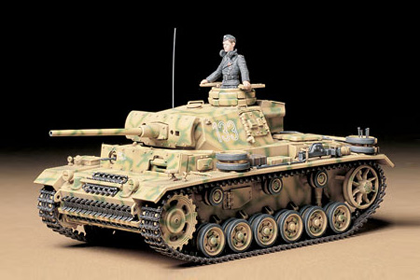
As it was manufactured at the existing tank factory, the basic performance and structure were the same as previous versions with a few modifications. Armament consisted of an improved, long barreled Kwk50 L/60 tank gun, which was effective against the Russian T34 tanks up to a range of 600m, plus two 7.92mm MG34 machine guns. The armor of the front superstructure was increased to 57mm in thickness, and a 20mm thick spaced armor was added to the gun mantlet as well, which increased the tank’s weight by 200kg.
To cope with the added weight, the suspension system was also strengthened. The powerplant was a Maybach HL120TRM, V-12, water cooled engine producing 300 horsepower. In total 635 Ausf. L’s were produced by the end of 1942, and many of them saw active service on the Eastern Front and the North African Front. Although its roll was shortly replaced by the Tiger I and the Panther, the durable chassis of the Pz.Kpfw.III was used for self-propelled guns till the end of the war.
This is the Tamiya 35 246 kit in 1/35 scale, of the ‘German 18 Ton Heavy Half-Track Famo and Tank Transporter’.
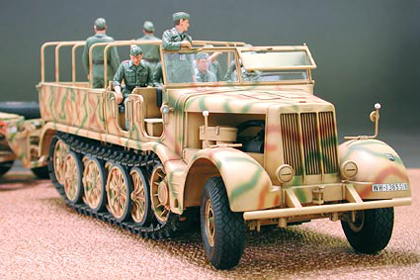
As World War II progressed, the vehicles used on the battlefields became larger and larger. When these mammoth machines broke down or became damaged, the task of bringing them back from the front lines was not an easy one. This need was especially felt by the German Wehrmacht, who were fighting on a wide range of battlegrounds: from the scorching desert of North Africa to the railroad lacking plains of Russia. Bringing damaged vehicles back from these difficult conditions was indispensable to replenishing fighting strength to the army.
The German 18 Ton Heavy Half-Track “FAMO” and Tank Transporter Sd.Ah.116 was one of the vehicles that contributed to this task. Including all variations, over 2500 18 ton half-tracks were produced by the end of the WWII. One of the major types was the tank recovery half-track, which was a mighty towing vehicle equipped with two rows of seats and a flatbed in back for the storage of equipment such as a draw-bar and spare wire rope. Tool storage compartments were found on each of the outer sides of the flatbed. In addition, the underside of a vehicle was equipped with a winch.
Its powerplant was a Maybach HL 108 12-cylinder engine, which put out 270hp. Tank transporting was conducted by either direct towing with a draw bar, or by loading the tank atop a massive trailer. Officially known as “Sd.Ah.116”, the Type 116 Trailer connected with the 18ton heavy half track, which allowed for the transportation of 22-23 ton class tanks such as the Pz.Kpfw.III, Pz.Kpfw.IV and other heavy artillery.
This is the Tamiya 35 317-2000 kit in 1/35 scale, of the ‘German 6×4 Truck, Krupp Protze, Personnel Carrier’.
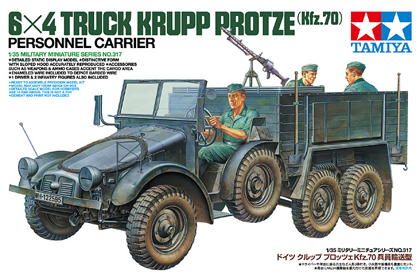
It featured a sloped hood that housed a compact air-cooled inline 4-cylinder engine as well as rear double wishbone independent suspension which offered a superb off-road capability. The large cargo area was fitted with bench seats.
The Sd.Kfz.70s were produced from 1993 to 1942 and were widely deployed with infantry units, etc. Many of them deployed to frontlines were equipped with a tripod-mounted MG34 machine gun.
This is the Dragon 6632 kit in 1/35 scale, of the ‘Panzerkampfwagen III, Ausf. F’.
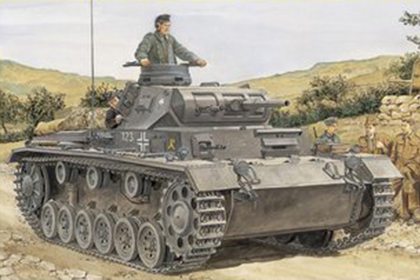
It was intended to fight other armoured fighting vehicles and serve alongside the infantry-supporting Panzer IV. However, as the Germans faced the formidable T-34, stronger anti-tank guns were needed. Since the Panzer IV had a bigger turret ring, the role was reversed. The Panzer IV mounted the long barreled 7.5 cm KwK 40 gun and engaged in tank-to-tank battles.
The Panzer III became obsolete in this role and for most purposes was supplanted by the Panzer IV. From 1942, the last version of Panzer III mounted the 7.5 cm KwK 37 L/24, better suited for infantry support. Production of the Panzer III ended in 1943. However, the Panzer III’s capable chassis provided hulls for the Sturmgeschütz III until the end of the war.
![]()
This is the Eduard, photo etch set for the ‘Russian Heavy Tank, KV-1 Ehkranami‘ from Trumpeter.
Detail set |
Trumpeter |
||||
| (35 884) | Basic | 00357 | |||
Source: Eduard
This is the Dragon 6291 kit in 1/35 scale, of the ‘German Panzerkampfwagen IV, Ausf. C’.
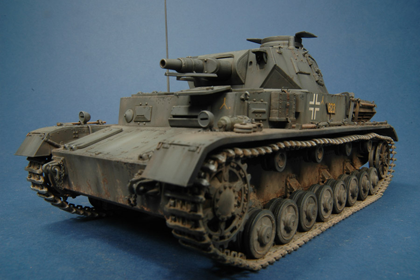
The Panzer IV was the most common German tank of World War II, and was used as the base for many other fighting vehicles, such as tank destroyers and self-propelled antiaircraft gun.
The Panzer IV has the distinction of being the only German tank to remain in continuous production throughout all of WWII, with over 9,000 produced since 1939. Only 138 “C” versions were made between 1938 and 1939.
This is the Trumpeter 00311 kit in 1/35 scale, of the ‘Russian Heavy Tank, KV-2 model 1939, big turret’.
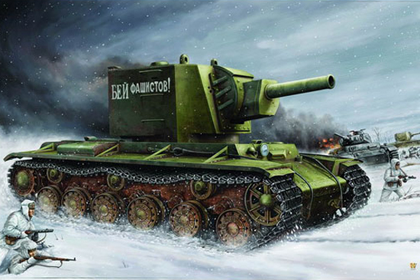
The first of this type uses a new big high turret of 7 sides that mounting the 152mm M-10 howitzer. This version, which had many detail differences to the later standard type was usually dubbed KV ‘Big Turret’ or KV-2 Model 1939. As such a big turret on the usual KV hull proved to be very un-maneuverable it soon earned a funny nickname of “Mobile washroom”!
This is the Trumpeter 00357 kit in 1/35 scale, of the ‘Russian Heavy Tank, KV-1 Ehkranami’.
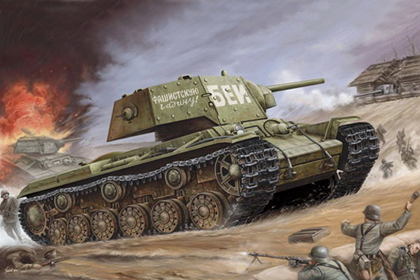
Since the capability of producing such a thick armor plate was lacking at the time, so an interim solution was to use bolt on armor, 25mm of thickness, bolt directly to the outside of the turret and some other parts of the hull. This type was usually referred to as KV-1s Ehkranami.
This is the Dragon 6463 kit in 1/35 scale, of the ‘German Panzerkampfwagen III, Ausf. J – Initial production’.
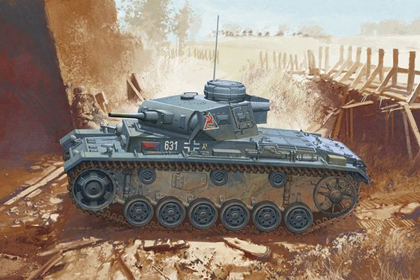
One solution was to up-gun the tank with a longer and more powerful 5cm KwK 38 L/42 cannon, and to add more armor to the vehicle. Thus the Panzer III Ausf. J was born. It featured 50mm-thick solid armor plates on the front and rear of the hull, an increase from the previous 30mm-thick armor plates.
Among other modifications, the new armor resulted in a ball-mount MG being fitted on the front superstructure and a redesigned driver’s visor.
This is the Trumpeter 00358 kit in 1/35 scale, of the ‘Russian Heavy Tank, KV-1 model 1942 simplified turret’.
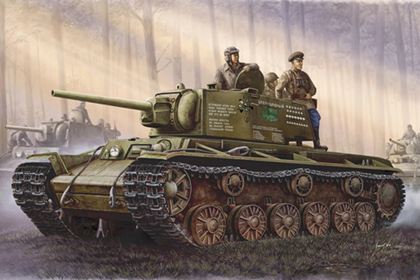
The bodywork armor was again 75 millimeters of to increase 90 millimeters of, dry by heat the most thick place in armor of the tower attains 120 millimeters.